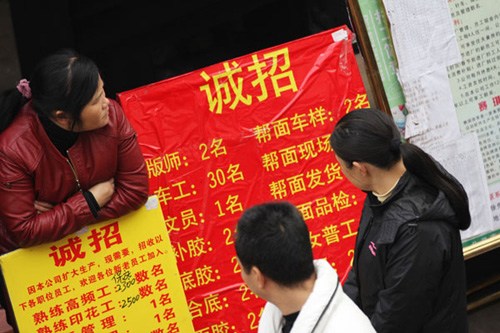
An employment market attracts few job seekers in Jinjiang city, Fujian province, traditionally one of China's largest production bases for shoes and clothing. However, it has continued to see a shortage of labor this year, particularly of skilled workers.
A structural problem
"China's labor shortage is not a lack of labor in the general sense. In fact, it is a structural problem and refers to a labor shortage in some professions, industries and regions," said Zhou Tianyong, an economics professor at the Party School of the Central Committee of Communist Party of China in Beijing.
As a point in case, South China's Guangdong Province, the nation's production and export base, is short of about 800,000 laborers this year, according to a spokesman for the provincial department of human resources and social security. The shortage has mainly hit labor-and service-intensive industries, including textiles, catering and shoemaking. Meanwhile, industrial upgrades will simply exacerbate the shortage of technical workers in the future, the spokesman added.
Moreover, this year's employment outlook for graduates is tougher than ever, because 2012 will see 200,000 more graduates than last year.
"Cities and towns will see 25 million extra people joining the workforce this year, more than half of whom will be university and college graduates, while another 9 to 10 million will be surplus rural laborers," said Yin Weimin, minister of human resources and social security, at a news conference in March.
Graduates are finding it difficult to get jobs and many enterprises are facing problems in recruiting workers and technicians, revealing structural problems in the employment market, said Yin.
According to Rong Lanxiang, president of Shandong Lanxiang Vocational School, the country's higher education system needs to be adjusted. "What students learn in college should be in line with social demand. Moreover, providing training in job skills would help to address the employment difficulties faced by college graduates, while at the same time addressing the shortage of skilled professionals," said Rong.

Copyright ©1999-2011 Chinanews.com. All rights reserved.
Reproduction in whole or in part without permission is prohibited.